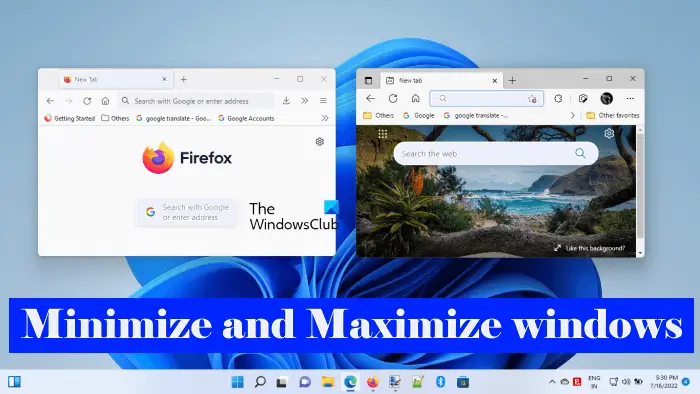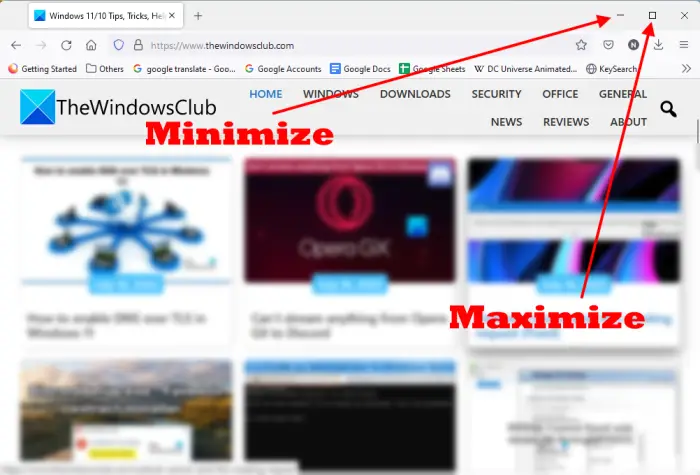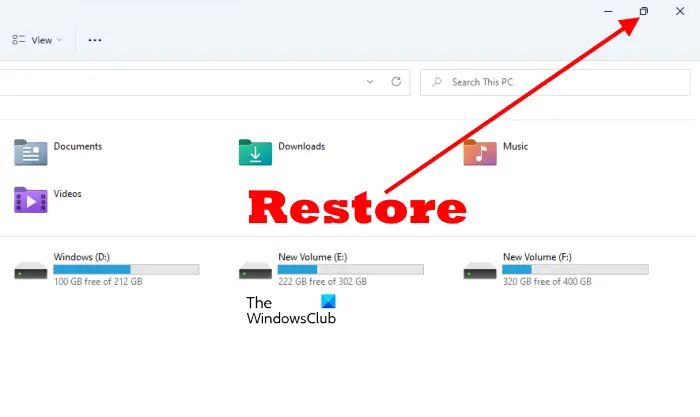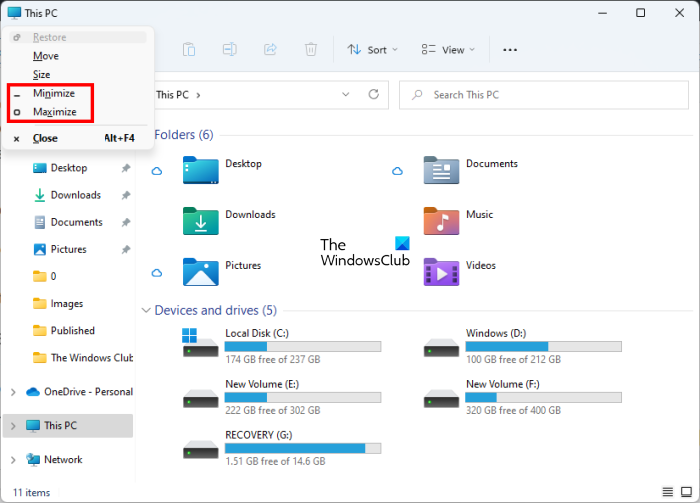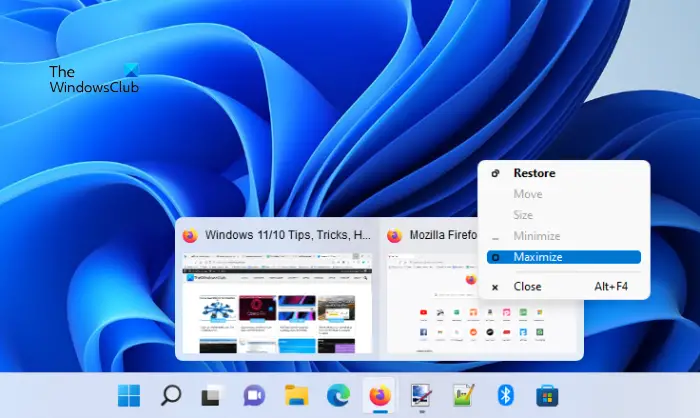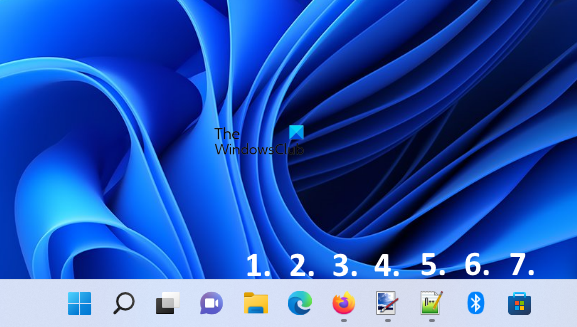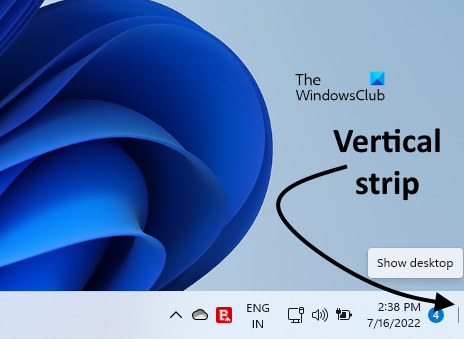On Windows Vista, I’m familiar with 
What hotkey can I use to minimise only the currently active window?
Gaff
18.6k15 gold badges57 silver badges68 bronze badges
asked Sep 16, 2010 at 4:16
I’ve been using the shortcut Alt+Space followed by N for years. Works on any Windows version, all the way back to Windows 3.0! It should work with all keyboard layouts and probably even all Windows localizations.
Alt+Space opens the general windows menu. You can open it manually by left-clicking with the mouse on the top left window corner.
The menu contains the options to maximize, minimize, close the window, etc. It also underlines the key you need to press to select the appropriate option («miNimize»).
The N is not a general «hotkey» but an access key – a keyboard shortcut to an entry in a GUI menu that works only if/after the menu opens. The menu items texts differ across localizations (languages), which is why a different letter might be underlined and serve as the access key.
Palec
4865 silver badges20 bronze badges
answered Sep 16, 2010 at 7:31
11
A small workaround is Alt + Esc – it doesn’t minimize the active window but places it behind all other windows. The effect is similar however.
I know it’s not precisely what the question asker wanted, but it’s a built-in Windows one-step solution that works in a similar way.
Gaff
18.6k15 gold badges57 silver badges68 bronze badges
answered Oct 25, 2016 at 18:25
VeldaVelda
1,8901 gold badge11 silver badges4 bronze badges
6
In Windows 7 and later you can minimize the currently active window with: Win+Down.
(This may be an Aero feature that works with Vista as well.)
nixda
26.9k17 gold badges109 silver badges156 bronze badges
answered Sep 16, 2010 at 5:35
KrakenSoupKrakenSoup
1,0451 gold badge6 silver badges2 bronze badges
9
When maximized:
- Windows key + press the down arrow twice.
When not maximized:
- Windows key + press the down arrow once.
answered Sep 20, 2013 at 20:00
RickyRicky
6495 silver badges2 bronze badges
4
AutoHotKey script for Minimize:
;=============================================================================;
; WINDOWS KEY + Alt + Down -- Minimizies Active window
;=============================================================================;
; instead of "Restore Down" for Win+Down
#!Down::WinMinimize, A
Explanation:
- Format:
[Key-Combination]::[Action] #!Down— will execute when Windows-Key (#), Alt-Key (!), Down-Arrow-Key (down) are pressed togetherWinMinimize, Awill mimimize (WinMinimize) the active (A) window
answered Mar 15, 2016 at 9:57
Sam HaslerSam Hasler
5001 gold badge9 silver badges20 bronze badges
3
according to microsoft support, there isn’t one, but it is easily scripted in autoit.
EDIT: Below is a very very basic sample of how to accomplish a hotkey to minimize the focused window, fully commented.
#include <WinApi.au3> ;include winAPI library
HotKeySet("!M",'_MinimizeActive') ;sets hotkey to Alt+Shift+m to trigger function
While 1 ;loop to keep alive
WEnd
Func _MinimizeActive()
Local $v_Wnd, $w_Wnd ;declare variables
$v_Wnd = _WinAPI_GetFocus() ;get focused window
$w_Wnd = WinGetHandle($v_Wnd) ;get handle of focused window
WinSetState($w_Wnd,"",@SW_MINIMIZE) ;minimize focused window
EndFunc
answered Sep 16, 2010 at 4:22
MaQleodMaQleod
13.2k4 gold badges40 silver badges61 bronze badges
3
If what you want is an easy way to open and minimize a window you use often, just pin it to the task bar and move it to one of the first positions. Then you can use Windows+1, 2, 3 etc. to quickly toggle the window.
No more scrolling through loads of windows with ´Alt´+´Tab´ to maximize it again either.
answered Mar 19, 2015 at 15:52
1
Because windows doesn’t have a shortcut key for it, you may use a 3rd party solution, like autoit to do that.
Below is a simple script for it. This first to set a hotkey (with HotKeySet()), than minimize current window (with WinSetState()).
#include <WinApi.au3>
HotKeySet("!M",'MinimizeWin') ;Alt+Shift+m
While 1
Sleep(100)
WEnd
Func MinimizeWin()
WinSetState("[ACTIVE]", "", @SW_MINIMIZE)
EndFunc
answered Oct 28, 2015 at 14:17
xxxbencexxxbence
1,0197 silver badges4 bronze badges
Although this is also another two-step solution, but I find it more nerve-friendly as it clears everything from my mind on the first step:
- win + m: Minimize All Windows
- alt + tab: Choose A Window You Want To Work With
answered May 13 at 21:00
aderchoxaderchox
2583 silver badges9 bronze badges
2
You must log in to answer this question.
Not the answer you’re looking for? Browse other questions tagged
.
Not the answer you’re looking for? Browse other questions tagged
.
|
Press this key |
To do this |
|---|---|
|
Windows logo key |
Open or close Start. |
|
Windows logo key + A |
Open Quick Settings. Updated in Windows 11. |
|
Windows logo key + B |
Set focus to the first icon in the Taskbar corner. |
|
Windows logo key + C |
Open Windows Copilot. Updated in Windows 11. |
|
Windows logo key + Shift + C |
Open the charms menu. |
|
Windows logo key + Ctrl + C |
Turn on color filters (enable this shortcut first in Color Filter settings). |
|
Windows logo key + D |
Display and hide the desktop. |
|
Windows logo key + E |
Open File Explorer. |
|
Windows logo key + F |
Open Feedback Hub and take a screenshot. |
|
Windows logo key + G |
Open Xbox Game Bar when a game is open. |
|
Windows logo key + Alt + B |
Turn HDR on or off. Note: Applies to the Xbox Game Bar app version 5.721.7292.0 or newer. To update your Xbox Game Bar, go to the Microsoft Store app and check for updates. |
|
Windows logo key + H |
Launch voice typing. Updated in Windows 11. |
|
Windows logo key + I |
Open Settings. |
|
Windows logo key + J |
Set focus to a Windows tip when one is available. When a Windows tip appears, bring focus to the Tip. Pressing the keyboard shortcuts again to bring focus to the element on the screen to which the Windows tip is anchored. |
|
Windows logo key + K |
Open Cast from Quick Settings. Updated in Windows 11. |
|
Windows logo key + Alt + K |
Toggle microphone mute in apps that support Call Mute. Available starting in Windows 11, version 22H2. |
|
Windows logo key + L |
Lock your PC or switch accounts. |
|
Windows logo key + M |
Minimize all windows. |
|
Windows logo key + Shift + M |
Restore minimized windows on the desktop. |
|
Windows logo key + N |
Open notification center and calendar. Updated in Windows 11. |
|
Windows logo key + O |
Lock device orientation. |
|
Windows logo key + P |
Choose a presentation display mode. |
|
Windows logo key + Ctrl + Q |
Open Quick Assist. |
|
Windows logo key + R |
Open the Run dialog box. |
|
Windows logo key + Alt + R |
Record video of game window in focus (using Xbox Game Bar). |
|
Windows logo key + S |
Open search. |
|
Windows logo key + Shift + S |
Take a screenshot of part of your screen. |
|
Windows logo key + T |
Cycle through apps on the taskbar. |
|
Windows logo key + U |
Open Accessibility Settings. |
|
Windows logo key + V |
Open the clipboard history. Note: Clipboard history isn’t turned on by default. If you’d like to turn it on, use this keyboard shortcut and then select the prompt to turn on history. Or you can select Start > Settings > System > Clipboard , and set Clipboard history to On. |
|
Windows logo key + Shift + V |
Set focus to a notification. |
|
Windows logo key + W |
Open Widgets. Updated in Windows 11. |
|
Windows logo key + X |
Open the Quick Link menu. |
|
Windows logo key + Y |
Switch input between Windows Mixed Reality and your desktop. |
|
Windows logo key + Z |
Open the snap layouts. Updated in Windows 11. |
|
Windows logo key + period (.) or semicolon (;) |
Open emoji panel. |
|
Windows logo key + comma (,) |
Temporarily peek at the desktop. |
|
Windows logo key + Pause |
Opens Start > Settings > System > About . |
|
Windows logo key + Ctrl + F |
Search for PCs (if you’re on a network). |
|
Windows logo key + number |
Open the desktop and start the app pinned to the taskbar in the position indicated by the number. If the app is already running, switch to that app. |
|
Windows logo key + Shift + number |
Open the desktop and start a new instance of the app pinned to the taskbar in the position indicated by the number. |
|
Windows logo key + Ctrl + number |
Open the desktop and switch to the last active window of the app pinned to the taskbar in the position indicated by the number. |
|
Windows logo key + Alt + number |
Open the desktop and open the Jump List for the app pinned to the taskbar in the position indicated by the number. |
|
Windows logo key + Ctrl + Shift + number |
Open the desktop and open a new instance of the app located at the given position on the taskbar as an administrator. |
|
Windows logo key + Tab |
Open Task view. |
|
Windows logo key + Up arrow |
Maximize the window. |
|
Windows logo key + Alt + Up arrow |
Snap window in focus to top half of screen. New with Windows 11. |
|
Windows logo key + Down arrow |
Remove current app from screen or minimize the desktop window. |
|
Windows logo key + Alt + Down arrow |
Snap window in focus to bottom half of screen. New with Windows 11. |
|
Windows logo key + Left arrow |
Maximize the app or desktop window to the left side of the screen. |
|
Windows logo key + Right arrow |
Maximize the app or desktop window to the right side of the screen. |
|
Windows logo key + Home |
Minimize all except the active desktop window (restores all windows on second stroke). |
|
Windows logo key + Shift + Up arrow |
Stretch the desktop window to the top and bottom of the screen. |
|
Windows logo key + Shift + Down arrow |
Restore/minimize active desktop windows vertically, maintaining width. |
|
Windows logo key + Shift + Left arrow or Right arrow |
Move an app or window in the desktop from one monitor to another. |
|
Windows logo key + Shift + Spacebar |
Cycle backwards through language and keyboard layout. |
|
Windows logo key + Spacebar |
Switch input language and keyboard layout. |
|
Windows logo key + Ctrl + Spacebar |
Change to a previously selected input. |
|
Windows logo key + Ctrl + Enter |
Turn on Narrator. |
|
Windows logo key + Plus (+) |
Open Magnifier and zoom in. |
|
Windows logo key + Minus (-) |
Zoom out in Magnifier. |
|
Windows logo key + Esc |
Close Magnifier. |
|
Windows logo key + forward slash (/) |
Begin IME reconversion. |
|
Windows logo key + Ctrl + Shift + B |
Wake PC from blank or black screen. |
|
Windows logo key + PrtScn |
Save full screen screenshot to file. |
|
Windows logo key + Alt + PrtScn |
Save screenshot of game window in focus to file (using Xbox Game Bar). |
|
Windows logo key + Alt + Enter (on taskbar item focus) |
Open taskbar settings. |
Use the following shortcuts:
- Minimize the current window: Windows+Down Arrow.
- Maximize the current window: Windows+Up Arrow.
- Minimize all windows: Windows+M.
- Minimize all windows and show the desktop: Windows+D.
- Minimize all windows except the current one: Windows+Home.
- Restore all minimized windows: Windows+Shift+M.
Contents
- 1 How do I minimize a single window?
- 2 What is the shortcut to open minimize window?
- 3 How do I manually minimize a window?
- 4 What is Ctrl P?
- 5 How do I switch screens using windows with the keyboard?
- 6 How do I minimize windows without Minimize button?
- 7 What Ctrl V means?
- 8 What is Ctrl G?
- 9 What Ctrl Z do?
- 10 How do you switch between screens?
- 11 How do I switch displays?
- 12 What does Alt F4 do on a computer?
- 13 Why is V paste?
- 14 What is Ctrl D?
- 15 What is the full form of Ctrl J?
- 16 Is Ctrl P paste?
- 17 What is Ctrl F in Word?
- 18 How do you use Control J?
- 19 What does Ctrl M do?
- 20 What does Ctrl Shift Alt R do?
How do I minimize a single window?
However, if you want to minimize the single window of almost anything, hit this shortcut: Alt+Space+N. Alt+Space will do the same as a right click on the title bar.
What is the shortcut to open minimize window?
To minimize current window – hold Windows Key and press down arrow key. To maximize the same window (if you did not move on to any other window) – hold Windows Key and press up arrow key. Another way is to invoke the control box menu by pressing Alt+Space Bar and then press “n” for minimize or “x” for maximize.
How do I manually minimize a window?
To minimize the app you are using, press Windows + Down arrow on your keyboard. If the app is maximized, this minimize shortcut only restores it to its intermediate state, so you have to use it twice to hide the window from view. To maximize the current app, use the Windows + Up arrow keyboard shortcut.
What is Ctrl P?
Alternatively referred to as Control+P and C-p, Ctrl+P is a keyboard shortcut most often used to print a document or page. Tip. On Apple computers, the keyboard shortcut for print is Command + P .
How do I switch screens using windows with the keyboard?
Pressing Alt+Tab lets you switch between your open Windows. With the Alt key still pressed, tap Tab again to flip between windows, and then release the Alt key to select the current window.
How do I minimize windows without Minimize button?
Minimizing all open windows can be accomplished a variety of ways without the Windows key. On a PC, try pressing Alt + Tab ↹ to minimize each window individually or use taskbar buttons to minimize all open windows at once.
What Ctrl V means?
In a Windows PC, holding down the Ctrl key and pressing the V key pastes the contents of the clipboard into the current cursor location.
What is Ctrl G?
Updated: 12/31/2020 by Computer Hope. Alternatively known as Control+G and C-g, Ctrl+G is a keyboard shortcut often used to advance through Find results or move to a specific line in a document, spreadsheet, or text file. Tip. On Apple computers, this keyboard shortcut is performed using Command + G .
What Ctrl Z do?
To reverse your last action, press CTRL+Z. You can reverse more than one action. To reverse your last Undo, press CTRL+Y. You can reverse more than one action that has been undone.
How do you switch between screens?
To switch displays, hold down the left CTRL key + left Windows Key, and use the left and right arrow keys to cycle through the available displays.
How do I switch displays?
Dual Screen Setup for Desktop Computer Monitors
- Right-click on your desktop and select “Display”.
- From the display, select the monitor you wish to be your main display.
- Check the box that says “Make this my main display.” The other monitor will automatically become the secondary display.
- When finished, click [Apply].
What does Alt F4 do on a computer?
Alt + F4 is a keyboard shortcut that completely closes the application you’re currently using on your computer. Alt + F4 differs slightly from Ctrl + F4, which closes the current tab or window of the program you’re currently using.
Why is V paste?
“Well, Z, the last letter because it Undoes the last thing you’ve done. X for Cut because X looks like a pair of scissors. And V for Paste because it looks like the proofreading mark for ‘insert.So we get Windows H—a letter that doesn’t even appear in “Start Dictation.”
What is Ctrl D?
Alternatively referred to as Control+D and C-d, Ctrl+D is a keyboard shortcut that varies depending on the program. For example, in most Internet browsers, it is used to add the current site to a bookmark or favorite. But, other programs, like Microsoft PowerPoint, use it to duplicate objects.Ctrl+D in Microsoft Word.
What is the full form of Ctrl J?
Ctrl+J View downloads in browsers and set justify alignment in Microsoft Word.Ctrl+O Open a file in most programs. Ctrl+P Open a print window to print the page you’re viewing. Ctrl+R Reload page in browser or right align text in a word processor. Ctrl+S Save the document or file.
Is Ctrl P paste?
You’d need to have a non-intuitive print shortcut, and in that scenario you may well have ended up asking why Print is not Ctrl + P . If you really want to use separate hands for copying and pasting, you can use Ctrl + C for copying and Shift + Insert for pasting.
What is Ctrl F in Word?
What is Ctrl-F?Also known as Command-F for Mac users (although newer Mac keyboards now include a Control key). Ctrl-F is the shortcut in your browser or operating system that allows you to find words or phrases quickly. You can use it browsing a website, in a Word or Google document, even in a PDF.
How do you use Control J?
Ctrl+J in Word and other word processors
In Microsoft Word and other word processors, pressing Ctrl + J justifies the current line to evenly space its text or words between the left and right margins of the page. Full list of Microsoft Word shortcuts.
What does Ctrl M do?
In Microsoft Word and other word processor programs, pressing Ctrl + M indents the paragraph. If you press this keyboard shortcut more than once, it continues to indent further. For example, you could hold down the Ctrl and press M three times to indent the paragraph by three units.
What does Ctrl Shift Alt R do?
You can make a video recording of what is happening on your screen: Press Ctrl + Alt + Shift + R to start recording what is on your screen. A red circle is displayed in the top right corner of the screen when the recording is in progress. Once you have finished, press Ctrl + Alt + Shift + R again to stop the recording.
If you are a Windows user, you definitely know how to switch among the opened apps and how to minimize and maximize the opened windows. Almost all of us use the maximize and minimize buttons on the top right side of the apps for this purpose. Do you know there are multiple other ways in Windows 11/10 to maximize and minimize windows? In this article, we will see how to maximize and minimize windows in Windows 11/10.
If you have ever noticed that apart from maximizing and minimizing a window, there is one more option available in Windows 11/10, i.e., Restore. Before we begin our discussion on the different ways to maximize and minimize windows in WIndows 11/10, let’s see the difference between these three terms.
- Maximize: When we say maximize, we refer to the app that has covered the entire screen of a user’s computer irrespective of his screen size.
- Minimize: Minimizing an app hides it from your desktop or laptop screen without closing it. The app remains open but only gets hidden from your screen. You can access it by clicking on its icon on the Taskbar.
- Restore: Restoring a window neither maximizes it to the full screen nor minimizes it to the Taskbar. When you press the Restore button, the size of the selected window will change. You can consider it as a state between maximize and minimize. When you restore an app, both maximize and minimize options become available.
You can maximize and minimize active, inactive or all open windows in WIndows 11/10 by using the following methods:
- By using the maximize and minimize buttons
- By clicking on the Title Bar of the app
- By using the Title Bar menu
- From the Taskbar
- By using the keyboard shortcuts
- Maximize and Minimize all the opened windows
Let’s see all these methods in detail.
1] Maximize and Minimize windows in Windows 11/10 by using the maximize and minimize buttons
Let’s start with the method that is known to almost all Windows users. Almost all of you are familiar with this method. You can maximize and minimize the apps by clicking on the respective buttons. These buttons are available on the top right side of an app or opened window.
When an app is not opened in full-screen mode, you will see both maximize and minimize buttons on the top right side. The minus sign minimizes the app and the square box button maximizes the window or app. Click on the button as per your need.
When you maximize a window, you will see that the single square box button has turned into a double square box button. This is the Restore button. If you click on this button, the size of the opened window will change.
2] Maximize and Restore an app by clicking on its Title Bar
This trick does not minimize the window. Instead, it restores and maximizes it. To maximize and restore an app, you just have to double-click on the empty space on its Title Bar. If the app is opened in the full-screen mode, double-clicking on its Title bar will restore it and vice-versa.
3] Maximize and Minimize an opened window by using the Title Bar menu
Above, we have seen that double-clicking on the Title Bar of an opened window only maximizes and restores it. You cannot minimize an app by double-clicking on its Title bar. But if you use the Title Bar menu, you can maximize, minimize, and restore the window.
To bring the Title Bar menu, right-click on the Title Bar of an app or press the Alt + Spacebar. After that, select the desired option. In the Title Bar menu, you may find a certain option greyed out. This is because your app is currently in that mode. For example, if your app is in the full-screen mode (maximized), you will see that the Maximize option in the Title Bar menu is greyed out.
4] Maximize and Minimize windows from the Taskbar
The icons of the apps or programs that we open appear on the Taskbar. We can switch between the opened apps or programs by clicking on the respective icon on the Taskbar or by pressing the Alt + Tab keys. Most of you probably do not know that you can maximize and minimize the apps from the Taskbar.
The following steps will help you maximize and minimize windows from the Taskbar.
- Hover your mouse cursor over an app icon.
- You will see the thumbnail preview of that app. Right-click on it.
- When you right-click on the thumbnail preview, Windows will show you the menu to minimize, maximize, restore, and close the app.
- Select the desired option.
5] Maximize and Minimize the apps by using Windows 11/10 keyboard shortcuts
You can maximize and minimize the opened windows using keyboard shortcuts. Let’s see what these keyboard shortcuts are and how to use them.
- Win + Up Arrow Key: This key combination maximizes the window.
- Win + Down Arrow Key: When you use this keyboard shortcut, the opened window is first, restored, then minimized.
- Win + Right Arrow Key: Maximizes the window to the right of the screen.
- Win + Left Arrow Key: Maximizes the window to the left of the screen.
- Win + Home: This key combination minimizes all the windows except the active desktop window.
- Win + Number Keys: This keyboard shortcut is used to open the apps pinned on the Taskbar. For example, if you want to open the 4th app pinned on the Taskbar, you have to press the Win + 4 keys and so on. This keyboard shortcut works only for up to 9 apps because 9 is the largest single-digit number.
You can also use this Win + Number Keys shortcut to maximize and minimize the windows. For example, if you have opened an app that is pinned on the 6th number on the Taskbar, you have to press the Win + 6 keys to minimize it. Press the Win + 6 keys again to maximize it.
In the above screenshot, I have numbered the apps pinned on the Taskbar from 1 to 7. If all these apps are opened, the keyboard shortcuts to maximize and minimize the windows are as follows:
- Win + 1: File Explorer.
- Win + 2: Microsoft Edge.
- Win + 3: Mozilla Firefox.
- Win + 4: Paint dot net.
- Win + 5: Notepad++.
- Win + 6: Bluetooth.
- Win + 7: Microsoft Store.
6] Maximize and Minimize all the open windows
Pressing Win+M will minimize all open windows. If you want to maximize or minimize all the opened windows at once, you can use the Win+D keyboard shortcut. Pressing this shortcut will minimize all the opened windows. Pressing it again will maximize all the minimized windows. Apart from this keyboard shortcut, there is one more way to maximize and minimize all the opened windows at once. On the bottom right side of the Taskbar, there is a vertical strip. When you click on that strip, all the windows will be minimized. If you click on that vertical strip again, all the minimized windows will be maximized.
Read: How to Select, Copy and Paste, Delete, Rename Multiple Files and Folders in Windows 11/10
How do I maximize a window in Windows 11?
There are multiple ways to maximize a window in Windows 11. The most common way is to use the maximize button present on the top right side of an opened window. This is the method used by most Windows users. Apart from this, there are several other methods to maximize a window in Windows 11. You can use the keyboard shortcuts, Title Bar menu, etc., for the same. In addition to this, double-clicking on the Title Bar of the opened window also maximizes and restores the windows.
We have described all the methods to maximize and minimize windows in Windows 11/10 in this article.
Read: Windows 11 File Explorer Tips and Tricks
What are the shortcut keys for maximizing and minimizing the window?
You can use Win + Arrow Keys to maximize and minimize the windows. If you press the Win + Up Arrow Keys, your window will be maximized. If you press the Win + Down Arrow Keys, your window will be minimized. Apart from that, you can also use the Win + Number Keys for the same. We have explained all the keyboard shortcuts to maximize and minimize windows on Windows 11/10.
Hope this helps.
Read next: Managing Files and Folders in Windows.
In a computer, a keyboard short refers set of one or more keys that invoke a command in software or an operating system. Keyboard shortcuts provide an easier and quicker method of using computer programs. But its alternate means for invoking commands that would otherwise be accessible only through a menu, a mouse or an aspect of the interface. Here are some Most useful Windows 10 Keyboard Shortcuts keys Ultimate Guide To use windows computer more easily and smoothly.
Contents
- 1 Windows 10 Shortcut Keys
- 2 File Explorer Shortcuts
- 3 Windows System Commands
- 3.1 Create custom Keyboard Shortcuts
Windows 10 Shortcut Keys
Windows key + A opens Action center
— Advertisement —
Windows key + C Launch Cortana Assistant
Windows key + S Open windows search
Windows key + I Open SETTINGS app
— Advertisement —
Windows key + D Minimize or Maximize the current window
Windows key + E Launch Windows file explorer
Windows key + F Open Windows feedback hub
Windows key + G Open the hidden GAME bar
— Advertisement —
Windows key + H Open dictation, text to speech service
Windows key + I Open Settings
Windows key + K Display to wireless devices and audio devices
Windows key + L Lock the desktop
Windows key + M Minimize everything. Show desktop
Windows key + P Project to an external display
Windows key + Q Open Cortana
Windows key + R To open RUN Dialog Box
Windows key + S Open Search
Windows key + T Switch through the apps on taskbar
Windows key + U Go to Display directly in Settings app
Windows key + W Open Windows INK workspace
Windows key + X Power menu
Windows key + CTRL + D Add virtual desktop
Windows key + CTRL + Right Arrow Switch to virtual desktop on right
Windows key + CTRL + Left arrow Switch to virtual desktop on left
Windows key + CTRL + F4 Close the current virtual desktop
Windows key + TAB Open task view
Windows key + ALT + TAB Also opens task view
Windows key + Left Arrow Arrange current window to left edge of screen
Windows key + Right Arrow Arrange current window to right edge of screen
Windows key + Up Arrow Arrange current window to top of screen
Windows key + Down Arrow Arrange current window to bottom of screen
Windows key + Down Arrow (Twice) Minimize,current window
Windows key + Space bar Change input language (if installed)
Windows key + Comma ( ,) Temporarily peek at the desktop
Alt key + Tab Switch between open apps.
Alt key + Left arrow key Go back.
Alt key + Right arrow key Go foward.
Alt key + Page Up Move up one screen.
Alt key + Page down Move down one screen.
Ctrl key + Shift + Esc To open Task manager
Ctrl key + Alt +Tab View open apps
Ctrl key + C Copy selected items to clipboard.
Ctrl key + X Cut selected items.
Ctrl key + V Paste content from clipboard.
Ctrl key + A Select all content.
Ctrl key + Z Undo an action.
Ctrl key + Y Redo an action.
Ctrl key + D Delete the selected item and move it to the Recycle Bin.
Ctrl key + Esc Open the Start Menu.
Ctrl key + Shift Switch the keyboard layout.
Ctrl key + Shift + Esc Open Task Manager.
Ctrl key + F4 Close the active window
File Explorer Shortcuts
- End: Display bottom of current window.
- Home: Display top of current window.
- Left Arrow: Collapse the current selections or select a parent folder.
- Right Arrow: Display the current selection or select the first subfolder.
Windows System Commands
Type the following commands in your Run dialogue box (Windows Key + R) to run specific programs quickly.
- devmgmt.msc: open Device Manager
- msinfo32: To open System Information
- cleanmgr: Open the Disk Cleanup
- ntbackup: Opens the Backup or Restore Wizard (Windows Backup Utility)
- mmc: Opens the Microsoft Management Console
- excel: It opens the Microsoft Excel (if MS office is installed on your device)
- msaccess: Microsoft Access (if installed)
- powerpnt: Microsoft PowerPoint (if installed)
- winword: Microsoft Word (if installed)
- frontpg: Microsoft FrontPage (if installed)
- notepad: Opens the Notepad app
- wordpad: WordPad
- calc: Opens Calculator app
- msmsgs: Opens the Windows Messenger app
- mspaint: Opens the Microsoft Paint application
- wmplayer: Opens Windows Media Player
- rstrui: Opens the System restore wizard
- control: Opens the windows Control Panel
- control printers: Opens the printers dialogue box
- cmd: To open Command Prompt
- iexplore: To open the Internet Explorer web browser
- compmgmt.msc: open the Computer Management screen
- dhcpmgmt.msc: start DHCP Management console
- dnsmgmt.msc: start the DNS Management console
- services.msc: Open windows Services consloe
- eventvwr: Opens the Event Viewer window
- dsa.msc: Active Directory Users and Computers (For windows server only)
- dssite.msc: Active Directory Sites and Services (For windows server only)
Create custom Keyboard Shortcuts
Yes Windows 10 allows you to create your custom keyboard shortcuts for any program, whether it’s a traditional “desktop” app, a new-fangled “universal app”
To do this follow the steps below.
- Locate the app shortcut on the desktop (for example chrome) right-click on it select properties,
- Under the Shortcut tab, you should see a line that says Shortcut key.
- Click the textbox next to this line and then tap the desired shortcut key on your keyboard. for example, you are looking for open google chrome with keyboard shortcut Windows + G
- Click apply and grand admin privileges if prompts for
- Now use the new keyboard shortcut to open up the program or app.
These are some most useful Windows 10 Keyboard Shortcuts and commands to use windows 10 more smoother and faster. If any missing or found new keyboard shortcuts share on the comments below.
Also read:
- Remove shortcut virus from pendrive and system permanently
- Windows 10 Keyboard Suddenly stopped working? Apply these solutions to fix it
- Useful Snipping Tool Shortcuts for Screenshots in Windows 10, 8.1 and 7
- Solved: keyboard and mouse not working after windows 10 update 2021
- 11 basic settings you must enable to Secure windows 10 Laptop/PC
